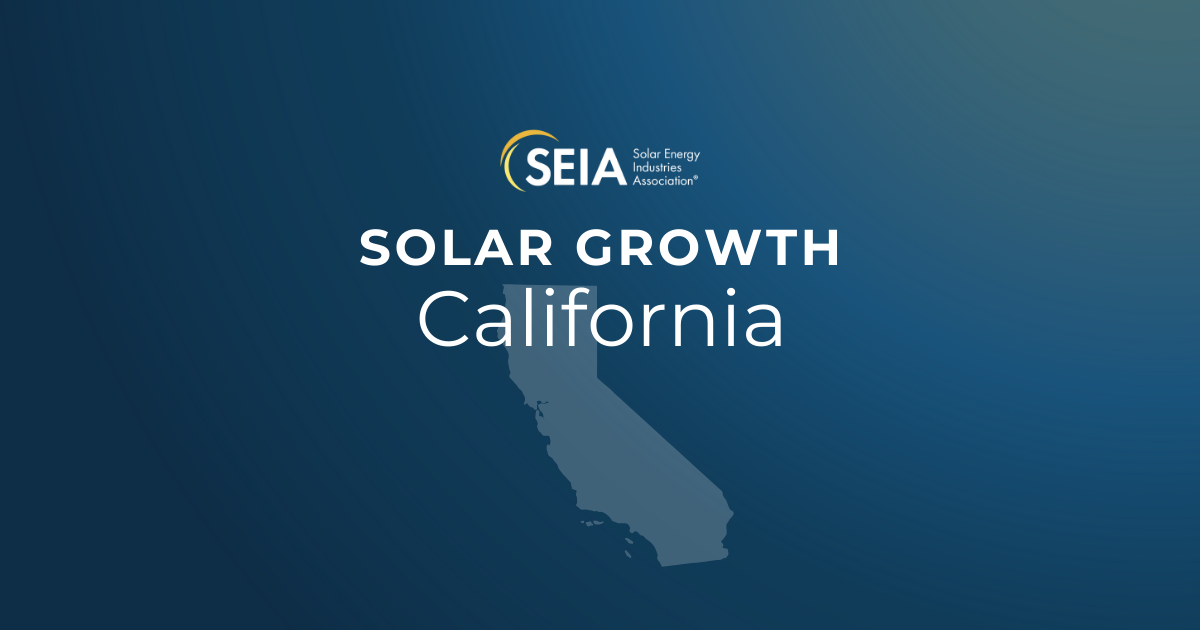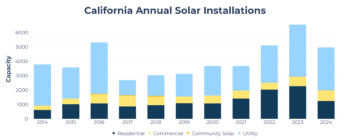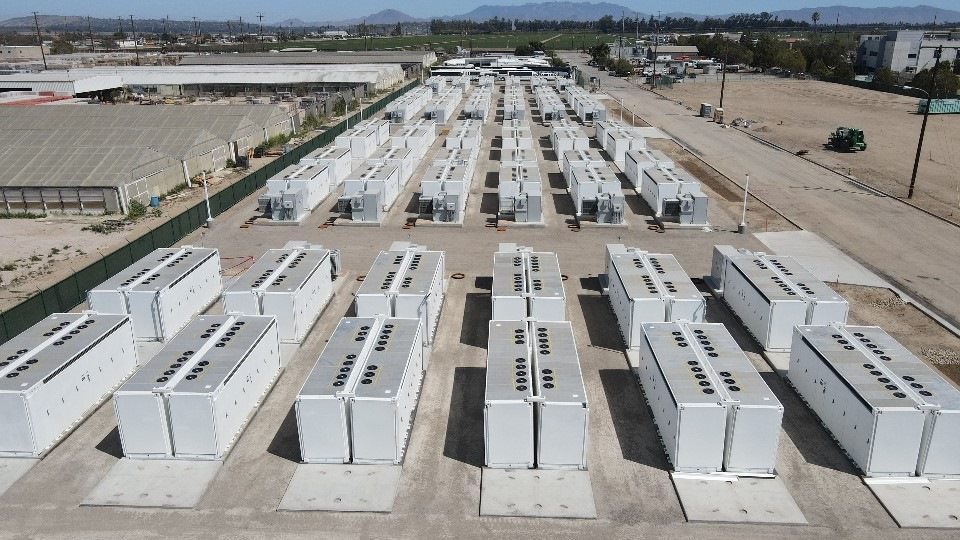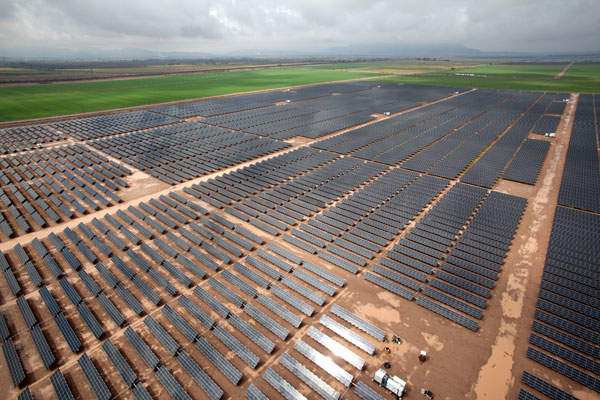State Overview
California
National Solar Capacity Ranking: 1st
Data Current Through: Q4 2024
California has the largest solar market in the U.S. and has been a longtime champion of solar because of the many economic and environmental benefits it provides, including billions in local investment. California has over 49,000 MW of installed capacity and solar supplies more than 31 percent of California’s electricity today, but it must play a bigger role if the state is to reach climate and energy goals.

California State Solar Overview
California has the largest solar market in the U.S. and has been a longtime champion of solar because of the many economic and environmental benefits it provides, including billions in local investment. California has over 49,000 MW of installed capacity and solar supplies more than 31 percent of California’s electricity today, but it must play a bigger role if the state is to reach climate and energy goals.
California Policy Priorities & Recent Highlights
- Dynamic Rates Applications (A.24-12-008 and A. 24-09-014) – These proceedings will address dynamic rate proposals of two of California’s largest investor-owned utilities. SEIA’s participation will be directed towards ensuring that the adopted rates allow for the enhancement of the value of solar and storage investments for all customer classes.
- Integrated Resources Proceeding (R.20-05-003) – While this proceeding has been ongoing since 2020, a significant portion of 2025 will be spent on the development of a Reliable and Clean Power Procurement Program aimed at establishing a programmatic approach to required procurement for all load serving entities under the jurisdiction of the California Public Utilities Commission. SEIA’s participation will advance the interests of solar and storage in this procurement program.
- Fixed Charge (R. 22-07-005) – As the implementation of the residential fixed charges adopted in 2024 will have major impacts on incentives for new customers to go solar as well as impact savings for current customers, SEIA will work in this proceeding to deter increases in the fixed charge and to find alternative rate designs which will serve to lower bills and enhance electrification.
- Community Solar (A. 22-05-022) – SEIA will continue its effort at the California Public Utilities Commission to help fashion a program that allows Californians to benefit from community solar and is workable for the developer community. Concurrently, SEIA will be working through other avenues, such as the California Energy Commission, to have policies enacted that will enhance the value of in- front- of- the- meter distributed solar resources to the electric grid.
- Avoided Cost Calculator – SEIA continues to advocate for significant improvements to the CPUC’s avoided cost calculator tool, which will be used to determine the benefits that distributed solar provides.
- PV Recycling– We continue to advocate for a flexible and scalable PV recycling program for solar systems through the legislature to enable California to both recycle in state and move panels out of state to legitimate recyclers.
- Tax Conformity – We are working to ensure California conforms to federal tax law to take full advantage of federal investment tax credits for transferability and direct pay by advocating for a legislative fix. We are currently supporting SB 203 from Senator Padilla which works to address this issue and allow ratepayers to see the benefits of affordable energy projects.
- Interconnection – SEIA continues to advocate at the CAISO for improvements to their recent IPE process and follow up on how those changes play out for solar developers in the state.

Just The Facts
-
Solar Installed (MW):
50,640
-
National Ranking:
1st (2nd in 2024)
-
Enough Solar Installed to Power:
14,954,169 homes
-
Percentage of State's Electricity from Solar:
32.35%
-
Solar Jobs:
80,056
-
Solar Companies in State:
2169 (384 Manufacturers, 958 Installers/Developers, 827 Others)
-
Total Solar Investment in State:
$111.9 billion
-
Prices have fallen:
42% over the last 10 years
-
Growth Projection and Ranking:
19,038 MW over the next 5 years (ranks 2nd)
-
Number of Installations:
2,166,539
California Policy Resources
- California Public Utilities Commission (CPUC)
- CPUC: Customer-Sited Renewable Energy Generation
- CPUC: Integrated Resource Plan and Long Term Procurement Plan (IRP-LTPP)
- California Energy Commission
- California Energy Commission: Distributed Energy Resources
- California Energy Commission: Integrated Energy Policy Report – IEPR
- California Air Resources Board
- California Air Resources Board: AB 32 Climate Change Scoping Plan
California Workforce Development Resources
California Consumer Protection Resources
CPUC: California Solar Consumer Protection Guide
This guide is from the California Public Utilities Commission (CPUC), a government agency that regulates privately-owned utilities like Pacific Gas and Electric Company (PG&E), Southern California Edison Company (SCE), and San Diego Gas & Electric Company (SDG&E).
California Energy Storage Policy and Market Overview
Energy storage deployment in California is rapidly accelerating and procurement has increased by 1,250% since 2019. California is leading deployment with over 13,000 MW of storage capacity across nearly 155,000 sites. By 2045, the state expects to reach 52,000 MW of storage. However, the decision to phase out net metering for NEM 3.0 (Net Billing Tariff) presents market uncertainties.
The Energy Storage Systems Act (2010) was the first state legislation codifying an energy storage procurement policy, set at an aggressive 1,825 MW by 2020 with BTM carveouts. In 2024, California reaffirmed ambitious storage goals and set a long-duration energy storage target, planning for 2 GW by 2037. Coupled with swift regulatory guidelines, robust incentives, and state funding, the deployment of both BTM and grid-scale storage is thriving.
The statewide Self-Generation Incentive Program (SGIP) is a key component driving California’s successful market growth. SGIP is the largest solar and storage incentives program in the US, providing services valued at over $1 billion annually. California’s ambitious storage policies and incentives are forming one of the most robust procurements of energy storage infrastructure in the US.
California Energy Storage Policy Resources
- California Energy Storage Systems Survey– Dot density map tool tracking Utility-Scale, Commercial & Industrial, and Residential storage systems in California.
- Self-Generation Incentive Program (SGIP) –State incentives and adders for distributed energy resources, and energy storage.
- California Energy Commission Open Funding Solicitations –Energy Research and Development grants funding innovative decarbonization, resilience, and green technologies.
- California Energy Storage Procurement Study – State report on the storage market and future growth plans.
- Long Duration Energy Storage Program –Grant funding program investing in LDES. Find program initiatives, reports, and webinar events.
- DSIRE Incentives Database California – Clearinghouse for financial incentives, regulations, and rebates for energy storage and lithium-ion technologies in California and across the United States.
- Pacific Northwest National Laboratories Energy Storage Policy Database –Map of Procurement, Regulatory, Demonstration, Incentive, and Interconnection policies in California and across the United States.
- California Energy Storage Rebates & Incentives – EnergySage’s list of key storage incentives and rebates and see what programs you can benefit from.
- Energy Storage Cost in California – Up-to-date storage and solar-plus-storage pricing and find installers in California on EnergySage.
- California State Legislature– Pending, passed, and historical legislation affecting energy storage and battery systems, locate and contact individual legislators, and stay up to date on current legislative issues in California.
- California Public Utilities Commission – Governing body that regulates the electricity rates and services of California public utilities, search for regulatory dockets, programs, and initiatives.






